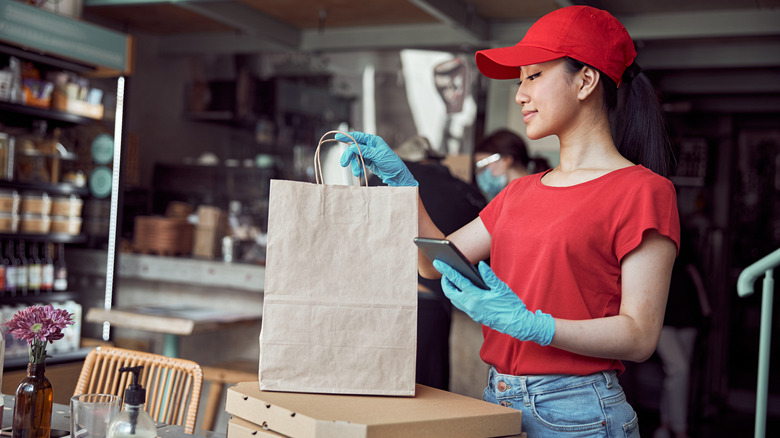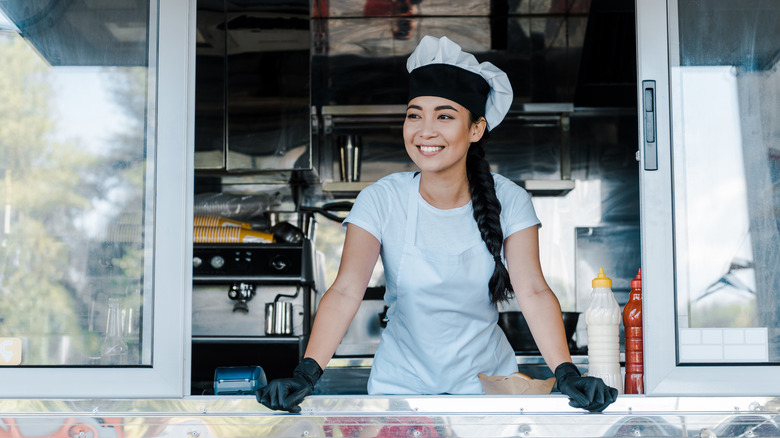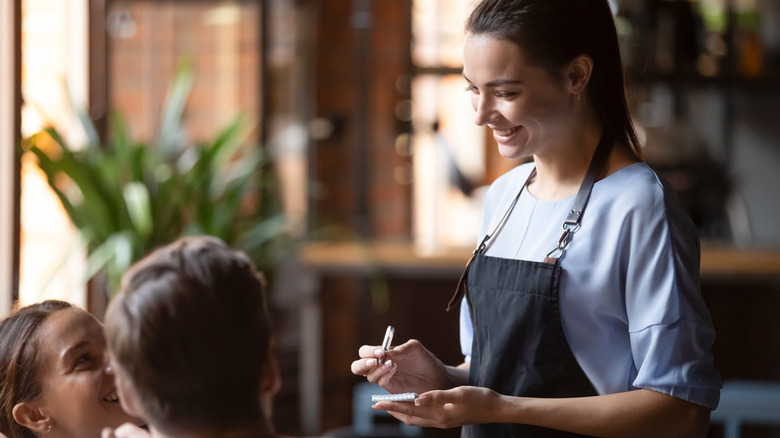Why Do We Always See Fast Food Workers Wearing Hats?
Hats are a customary accessory for nearly any type of work, including sports, the medical field, public safety, construction, and the food industry. Whether it's to shelter the worker from harm, protect eyes from sun damage, or act as a status symbol, hats play an essential role in our daily lives. But what makes them so important in fast food, and why should we care?
If you were to picture a chef, you'd likely first imagine the billowing white cap atop their heads accompanied by a long white coat. This hat, also known as a toque, was once used to categorize various kitchen workers, via Aussie Chef. Height, width, and details were vital in determining who ranked the highest among the cooks and differentiated them from other serving staff. It was also used to absorb sweat and preserve the kitchen's cleanliness, which played a significant part in the toque's creation.
According to the Auguste Escoffier School of Culinary Arts, the toque was invented after the execution of a chef by an infamous English monarch who supposedly detected hair in his food. Since then, wearing a toque in the kitchen has been a priority and has even spread to other food industries, such as those in convenience. Now, whenever we sit down or get take-out, food preparers are often seen wearing some form of headwear with their uniform. Though their style varies per restaurant, fast food employees must wear hats behind the kitchen. The main reason? To keep you safe.
Hats are required behind the counter
The Washington D.C. Department of Health states that workers near open food or cooking utensils must wear a hair restraint. For this reason, many fast food workers incorporate baseball caps, visors, and scarves into their uniforms (per Mental Floss). Hats also help keep fiddling hands away from hair and add to the restaurant's stylish representation.
Still, shedding is inevitable. In extreme cases, State Food Safety notes that sizable chunks of fallen hair are considered both a choking hazard and a health concern for unsuspecting patrons. According to Food Safety Helpline, hair can carry as many micro-viruses and harmful bacteria as it does keratin, a protein found in our organs, skin, and nails. Staphylococcus and ringworm are common pathogenic agents that can cause illnesses, infections, and rashes. That said, as tiny as it is, one hair follicle can potentially be a big problem — plus, it's just plain gross.
But if you do find hair in your food, chances are you will be completely fine (unless you take angel hair pasta too literally). Renowned dermatologist Maria Colavincenzo argues that this is not enough to make you ill or cause damage to your digestive tract, per Popular Science. Instead, you would have to consume nearly 250,000 strands, or enough hair to cover a human head, to obtain any physical destruction. Besides, there are much worse things hidden in our food that we are unaware of, such as microplastics and FDA-approved rat hair and maggots.
Why don't restaurant servers wear hats?
While it's still essential for sit-down restaurants to adhere to health and safety rules, they may apply differently for servers and bartenders. In more upscale settings, the waitstaff actually has minimal contact with food. Instead, Better Team reports that they spend most of their time refilling drinks, taking orders, presenting checks, and restocking supplies. This leaves the cooking to the chef and the back-of-house team, whereas fast food workers are the chefs and are continuously around exposed food. Still, those with longer hair primarily use ties and banded restraints to keep loose strands pulled back from their face.
According to Travel and Leisure, diners typically spend nearly two hours at a restaurant. Of course, this depends on the speed of service and whether the restaurant is moderately packed. Either way, it seems obvious that you see your server a lot more in a sit-down restaurant than you do in a fast-food service geared specifically toward speed and convenience. For this reason, sit-down restaurants want servers to look their best to properly represent the brand.
Take Hooters, for example. This casual restaurant is equally known for its strict uniform rules as much as its breaded hot wings. Often, Hooters requires servers to have their makeup done, their hair styled (yes, this means without restraints), and maintain a low weight. In fact, Hooters girls are so highly associated with the brand's look that they are considered "entertainers" rather than "servers" (via Eat This, Not That).


